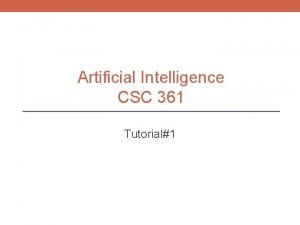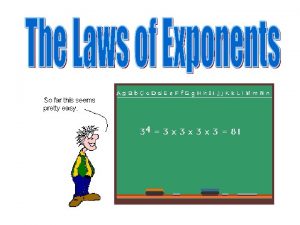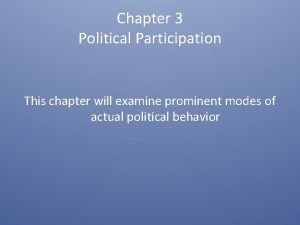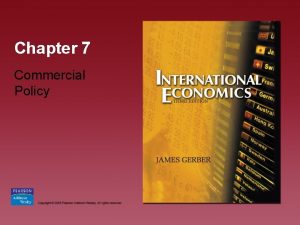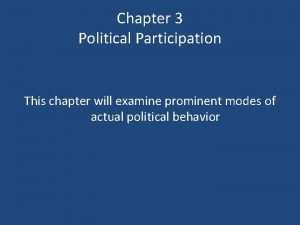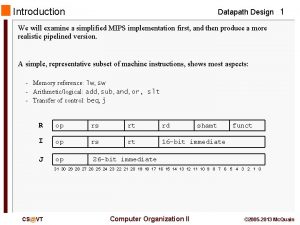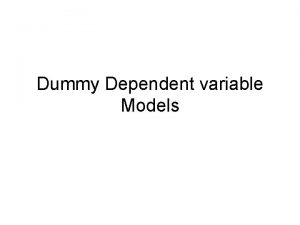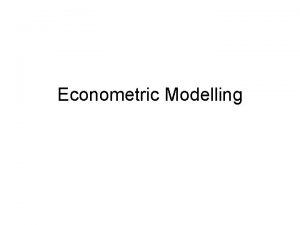1 Introduction n In this chapter we examine


![Basic Terms The Basic Terms: n V from PCP[D, V, ) Representation [. ] Basic Terms The Basic Terms: n V from PCP[D, V, ) Representation [. ]](https://slidetodoc.com/presentation_image_h/ba9c47bde5de96e99afccbeed9e360c2/image-3.jpg)



![Overview of the Tests n n In each tests the variables in [. ] Overview of the Tests n n In each tests the variables in [. ]](https://slidetodoc.com/presentation_image_h/ba9c47bde5de96e99afccbeed9e360c2/image-7.jpg)
![Simple Test: Points-on-Line Representation: n n n [. ] has one variable [p] for Simple Test: Points-on-Line Representation: n n n [. ] has one variable [p] for](https://slidetodoc.com/presentation_image_h/ba9c47bde5de96e99afccbeed9e360c2/image-8.jpg)


![Next Test: Line-vs. -Point Representation: n n [. ] has one variable [p] for Next Test: Line-vs. -Point Representation: n n [. ] has one variable [p] for](https://slidetodoc.com/presentation_image_h/ba9c47bde5de96e99afccbeed9e360c2/image-11.jpg)

![Global Consistency: Constant Error Thm [AS, ALMSS]: Probability of finding inconsistency, between value for Global Consistency: Constant Error Thm [AS, ALMSS]: Probability of finding inconsistency, between value for](https://slidetodoc.com/presentation_image_h/ba9c47bde5de96e99afccbeed9e360c2/image-13.jpg)






![Plane-vs. -Plane: Representation: n [. ] has one variable [p] for each plane p Plane-vs. -Plane: Representation: n [. ] has one variable [p] for each plane p](https://slidetodoc.com/presentation_image_h/ba9c47bde5de96e99afccbeed9e360c2/image-20.jpg)


![Plane-vs. -Plane: Consistency Thm[Ra. Sa]: As long as ³| |-c for some constant 1 Plane-vs. -Plane: Consistency Thm[Ra. Sa]: As long as ³| |-c for some constant 1](https://slidetodoc.com/presentation_image_h/ba9c47bde5de96e99afccbeed9e360c2/image-23.jpg)


- Slides: 25

1

Introduction n In this chapter we examine consistency tests, and trying to improve their parameters: n reducing the number of variables accessed by the test. n reducing the variables’ range. n reducing error probability. We present the tests: n Points-on-Line n Line-vs. -Point n Plane-vs. -Plane 2
![Basic Terms The Basic Terms n V from PCPD V Representation Basic Terms The Basic Terms: n V from PCP[D, V, ) Representation [. ]](https://slidetodoc.com/presentation_image_h/ba9c47bde5de96e99afccbeed9e360c2/image-3.jpg)
Basic Terms The Basic Terms: n V from PCP[D, V, ) Representation [. ] is a set of variables, for which a value is assigned, n The values are in the range 2 v, n The values correspond to a single, polynomial ƒ: a of global degree r 3

Basic Terms n Test n A set of Boolean functions (local tests) n Each depends on at most D representation’s variables. D from PCP[D, V, ) 4

Basic Terms n Consistency: n Measures an amount of conformation between the different values assigned to the representation variables. n We say that the values are consistent if they satisfy at least an -fraction of the local tests. 5

Affine subspaces n Let us define some specific affine subspaces of : n n lines( ) is the set of all lines (affine subspaces of dimension 1) of planes( ) is the set of all planes (affine subspaces of dimension 2) of 6
![Overview of the Tests n n In each tests the variables in Overview of the Tests n n In each tests the variables in [. ]](https://slidetodoc.com/presentation_image_h/ba9c47bde5de96e99afccbeed9e360c2/image-7.jpg)
Overview of the Tests n n In each tests the variables in [. ] represent some aspect of the given polynomial f, such as n f’s values on points of n f’s restriction to a line in n f’s restriction to a plane in The local-tests check compatibility between the values of different variables in [. ]. 7
![Simple Test PointsonLine Representation n n n has one variable p for Simple Test: Points-on-Line Representation: n n n [. ] has one variable [p] for](https://slidetodoc.com/presentation_image_h/ba9c47bde5de96e99afccbeed9e360c2/image-8.jpg)
Simple Test: Points-on-Line Representation: n n n [. ] has one variable [p] for each point p . The variables are supposedly assigned the value ƒ(p) Hence the range of the variables is: v = log | | 8

Points-on-Line: Test: n n n There’s one local-test for each line l lines( ). Each test depends on all points of l (altogether 2 r points). A test accepts if and only if the values are consistent with a single degree-r univariate polynomial 9

Points-on-Line: Consistency Def: An assignment to Alas, is said to be globally each consistent if values on local-test most points agree with a single, globaldepends degree-onr apolynomial. non constant number of variables (2 r) Thm[Ru. Su]: If a large (constant) fraction of the local-tests accept, then there is a polynomial ƒ (of degree-r) which agrees with the assigned values on most points. 10
![Next Test Linevs Point Representation n n has one variable p for Next Test: Line-vs. -Point Representation: n n [. ] has one variable [p] for](https://slidetodoc.com/presentation_image_h/ba9c47bde5de96e99afccbeed9e360c2/image-11.jpg)
Next Test: Line-vs. -Point Representation: n n [. ] has one variable [p] for each point p , supposedly assigned ƒ(p), Plus, one variable [l] for each line l lines( ), supposedly assigned ƒ ’s restriction to l. Hence the range of [l] is all degree-r univariate poly’s 11

Line-vs. -Point: Test: n n There’s one local-test for each pair of: n a line l lines( ), and n a point p l. A test accepts if the value assigned to [p] equals the value of the polynomial assigned to [l] on the point p. 12
![Global Consistency Constant Error Thm AS ALMSS Probability of finding inconsistency between value for Global Consistency: Constant Error Thm [AS, ALMSS]: Probability of finding inconsistency, between value for](https://slidetodoc.com/presentation_image_h/ba9c47bde5de96e99afccbeed9e360c2/image-13.jpg)
Global Consistency: Constant Error Thm [AS, ALMSS]: Probability of finding inconsistency, between value for [p] and value for line [l] on p, is high (constant) , unless most lines and most points agree with a single, global degree-r polynomial. Here D = O(1) V = (r+1) log| | & constant. 13

Can the Test Be Improved? Can error-probability be made smaller than constant (such as 1/log(n) ), while keeping each local-test depending on constant number of representation variables? 14

What’s the problem? Adversary: randomly partition variables into k sets, each consistent with a distinct degree-r polynomial This would cause the local-test’s success probability to be at least k-(D-1). (if all variables fall within the same set in the partition) 15

Consequently One therefore must further weaken the notion of global consistency sought after [ still, making sure it can be applied in order to deduce PCP characterization of NP ]. 16

Limited Pluralism Def: Given an assignment to ’s variables, a degree-r polynomial ƒ is said to be -permissible if it is consistent with at least a fraction of the values assigned. Global Consistency: assignment’s values consistent with any -permissible ƒ are acceptable. 17

Limited Pluralism - Cont. Formally: Def: A local test is said to err (with respect to ) if it accepts values that are NOT consistent with any -permissible degree-r ƒ ’s. 18

Limited Pluralism - Cont. n n Note that the adversary’s randomly partition does not trick the test this time: If the test accepts when all the variables are from a set consistent with an r-degree polynomial, then the polynomial is really permissible. 19
![Planevs Plane Representation n has one variable p for each plane p Plane-vs. -Plane: Representation: n [. ] has one variable [p] for each plane p](https://slidetodoc.com/presentation_image_h/ba9c47bde5de96e99afccbeed9e360c2/image-20.jpg)
Plane-vs. -Plane: Representation: n [. ] has one variable [p] for each plane p planes( ), n supposedly assigned the restriction of f to p. Hence the range of [p] is all degree-r two-variables poly’s 20

Plane-vs. -Plane: Representation 21

That is, a pair of plains intersecting by a line Plane-vs. -Plane: Test: n n There’s one local-test for each line l lines( ) and a pair of planes p 1, p 2 planes( ) such that l p 1 and l p 2 A test accepts if and only if the value of [p 1] restricted to l equals the value of [p 2] restricted to l. Here D=O(1), v=2(r+1)2 log| |. 22
![Planevs Plane Consistency ThmRa Sa As long as ³ c for some constant 1 Plane-vs. -Plane: Consistency Thm[Ra. Sa]: As long as ³| |-c for some constant 1](https://slidetodoc.com/presentation_image_h/ba9c47bde5de96e99afccbeed9e360c2/image-23.jpg)
Plane-vs. -Plane: Consistency Thm[Ra. Sa]: As long as ³| |-c for some constant 1 > c > 0, a local test err (w. r. t. ) with a very small probability, namely £ c’ for some constant 1 > c’ > 0. 23

Plane-vs. -Plane: Consistency Cont. The theorem states that, the plane-vs. -plane test, with very high probability (³ 1 - c’), either rejects, or accepts values of a -permissible polynomial. 24

Summary n n We examined consistency tests, Pointson-Line, Line-vs. -Point and Plane-vs. -Plane. By weakening to -permissible definition, we achieve an error probability which is below constant. 25
 Business ethics of nepalese firm
Business ethics of nepalese firm Study each picture carefully. write your beliefs
Study each picture carefully. write your beliefs Helping students examine their reasoning marzano
Helping students examine their reasoning marzano Playing a decent game of table tennis (ping-pong).
Playing a decent game of table tennis (ping-pong). Connection between language and thought
Connection between language and thought Discuss the rivals as a comedy of manners
Discuss the rivals as a comedy of manners Let a man examine himself
Let a man examine himself Pointed object used to examine specimens
Pointed object used to examine specimens Helping students examine their reasoning
Helping students examine their reasoning Linear depreciation function
Linear depreciation function Explain the following lines (104-110)
Explain the following lines (104-110) To examine in detail for a purpose
To examine in detail for a purpose Examine yourselves to see if you are in the faith
Examine yourselves to see if you are in the faith Look at the sentence below
Look at the sentence below Look at the picture again and answer the questions
Look at the picture again and answer the questions Criminology unit 3 notes
Criminology unit 3 notes Dissecting pins function
Dissecting pins function Examine your faith
Examine your faith Historical development of community development
Historical development of community development Method of work study
Method of work study Examine
Examine Umbraco examine search example
Umbraco examine search example Let us examine ourselves
Let us examine ourselves Cobol tallying
Cobol tallying Examine the power 53.
Examine the power 53. Objective adjective
Objective adjective



